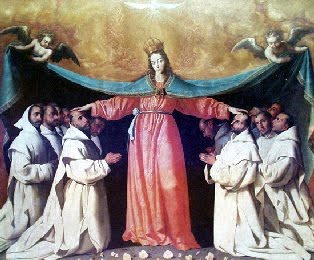 “They will carry the Crucifix in their right hand and the Rosary in their left, and the holy names of Jesus and Mary on their heart” ~ Saint Louis Marie de Montfort.
“They will carry the Crucifix in their right hand and the Rosary in their left, and the holy names of Jesus and Mary on their heart” ~ Saint Louis Marie de Montfort.Human logic suggests that a Man put to death by crucifixion and a string of beads are improbable, and yes, impossible sources to keep humanity from eternal death.
It also seems unlikely by human reasoning, that the Battle of Lepanto on 7 October 1571 would be a victory for Christianity because the Christians sought the help of Mary by praying on those beads.
Our Blessed Lady herself was told at the Annunciation that “no word shall be impossible with God” (Luke 1:37). The battle of Logic versus Faith that wages within each of us must always find Faith as the victor. Not that there’s anything wrong with logic, it is a gift from God given to His human creatures. But interiorly, logic can only walk to the mountain; but faith can climb the mountain.
The Virgin Mother of God didn’t need to comprehend everything that was told to her by Gabriel; after all, logic would say, how could a virgin become pregnant? But faith doesn’t simply walk to the mountain and see a dead end, faith climbs, albeit with much difficulty at times, but climbs nonetheless, in order to reach celestial heights, seeking God in order to say what Mary said: “Fiat!”
“And seeing the multitudes, He went up into a mountain, and when He sat down, His disciples came to Him. And opening His Mouth He taught them” (Matthew 5:1-2). “And going up into a mountain, He called to Him those He desired Himself; and they came to Him” (Mark 3:13). God teaches from the mountain, God calls from the mountain.
“And it came to pass in those days that He went out into a mountain to pray; and He passed the whole night in the prayer of God” (Luke 6:12). Jesus climbs a mountain to pray.
Combining these verses teaches something about the life of prayer: it is a dialogue – God calls, go up the mountain where He teaches the human soul; afterwards, the soul can pray, whether that be through words or just marveling in God’s presence.
Our Lady is the quickest and surest path to our Savior. She climbs the mountain with us. She knows where He is. In moments of weakness she takes our hand on that mountain and pulls us up past the more frightening crags. Saint John Berchmans said: “If I love Mary, I am certain of my salvation.” Saint Aloysius along those same lines said: “Servus Mariæ nunquam peribit” – “The servant of Mary will never be lost.”
These prophetic words from Sacred Scripture the Church places on the lips of Mary: “I am the Mother of fair love, and of fear, and of knowledge, and of holy hope. In me is all grace of the Way and of the Truth, in me is all hope of life and of virtue. Come over to me, all you that desire me, and be filled with my fruits. For my spirit is sweet above honey, and my inheritance above honey and the honeycomb. My memory is unto everlasting generations. He that hearkens to me shall not be confounded: and they that work by me, shall not sin. They that explain me shall have life everlasting” (Ecclesiasticus 24:24-28, 30-31).
Very powerful and faith building words!
On the Feast of Our Lady of Mercy, 5 August 1935, our Blessed Mother told Saint Faustina: “Be courageous. Do not fear apparent obstacles, but fix your gaze upon the Passion of my Son, and in this way you will be victorious” (Diary 449). This statement takes us back to the opening statement of this post from Saint Louis Marie de Montfort. In our left hand is the instrument in which we seek the help of our Mother and in our right hand is the means to help us keep our gaze fixed on the Passion of our Lord Jesus Christ.
The beads, the beads, the beads! They are a great means to make our hearts rejoice because as our fingers travel on them, fifty-three times we begin our prayer with the words: “Ave Maria!”
In the Carthusian tradition is the story of a lay-brother named Bruno Lhuillier. He had a great love for the Blessed Mother. “Ave Maria” constantly flowed from his lips. Many of his brother Carthusians, whenever they heard Brother Bruno Lhuillier proclaim those two words in praise of our Lady, they would respond using the same words. One day, one of his brothers, sort of beat him to the punch and was the first to say “Ave Maria.” Brother Lhuillier found great joy in that and responded: “Oh yes – Ave Maria – always, always” (Abbé Berseaux: Le Chartreuse de Bosserville).











